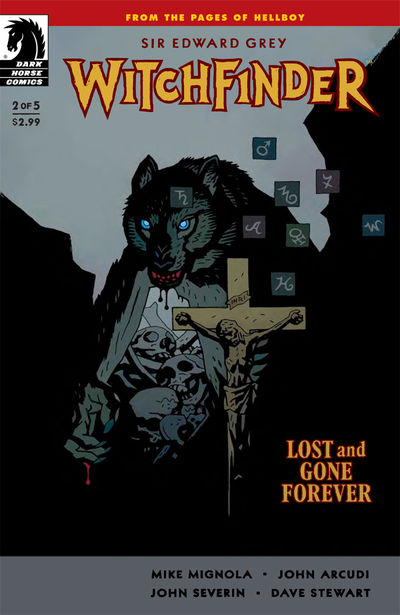Sir Edward Grey Witchfinder: Lost and Gone Forever 2
Reviewed by Peter Campbell 14-Mar-11
Sir Edward Grey Witchfinder is an excursion into the realms of gothic western. The western seems to be making a comeback, but it’s been infected by zombies and lycanthropes and invariably sultry witches. Why is this? Maybe it’s because it’s an era that already carries mythic overtones. Maybe it’s the looming, shadowed landscapes. Maybe it’s crass commercialism.
First thought: it’s a stunning cover, all blocky blacks and chiaroscuro, and it features a wolf, a crucified Christ, skull, bones and symbols of the zodiac. It’s by Mike Mignola, who also shares the writing credits. Closer inspection reveals that the wolf has an arm, rather clumsily tacked on to its body, which makes it not a wolf, but a werewolf.
Second thought: is John Severin still alive? Yet here he is, nearly ninety years old, still working away.
Sir Edward Grey Witchfinder is an excursion into the realms of gothic western. The western seems to be making a comeback, but it’s been infected by zombies and lycanthropes and invariably sultry witches. Why is this? Maybe it’s because it’s an era that already carries mythic overtones. Maybe it’s the looming, shadowed landscapes. Maybe it’s crass commercialism.
This is one of the better excursions into this hybrid genre. Since the cover bears the blurb “from the pages of Hellboy”, it’s presumably a spin-off from that series. Unfamiliarity with the characters doesn’t lessen the enjoyment any.
The format of the storyline, in this issue at least, is essentially picaresque, as the characters travel though the (looming, shadowed) landscapes. Along the way they encounter, either in the present, or by way of recollection, a witch, a werewolf, and a zombie.
Originality isn’t its strongest point then.
Accept that limitation, and it’s enjoyable enough. The opening scenes are probably the strongest, with a genuine sense of strangeness. There’s a particularly striking transition where it cuts from a character saying “Shhh. Listen. You got to listen,” and in the next panel you’re assaulted by the DUM-DUM-DIM-DUM-DUM of war drums. After that, it becomes a little more obvious, though it’s still structurally adventurous, in the way that it flips backward and forwards in time. With some strong dialogue that doesn’t venture too far into the realms of the hokey, it would be an above-average comic even that’s all it had to offer.
What’s really lifts the comic though is the art. John Severin’s always been a strong, classical artist, but the work on display here is a little looser than I’d associate with his style, reminiscent in places both of Bryan Talbot and Richard Corben – though it’s debatable in which direction the influence flows. He’s especially strong on facial expression and mood, with loose crosshatching adding depth and atmosphere to the narrative. He’s aided immeasurably by the colouring abilities of Dave Stewart who uses a restricted palette to great effect. It’s not very often that you look at the colours in a comic and are blown away the end results – it sounds as unlikely as raving about the letterer’s contribution – but it really is stunning. I’d be tempted to buy this on the strength of it alone.
This isn’t a top-notch comic. It relies too heavily on the props of its chosen genre for that. Nevertheless the skills on display here result in an attractive and absorbing read, and for that it’s worth investigating.
Tags: Dark Horse, Dave Stewart, Hellboy, John Arcudi, John Severin, Mike Mignola, Witchfinder